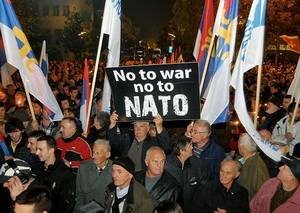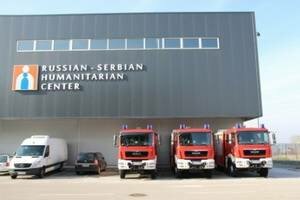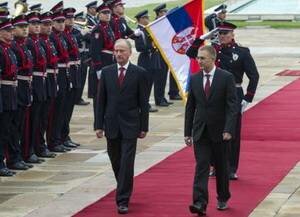
Yuriy Radkovets
Exacerbation of the conflict between Russia and the West over the “Ukrainian” and “Syrian” issues causes further growth of aggressiveness of Moscow's “hybrid policy” which turns to direct subversive activities against the countries of Europe. In this regard, the Kremlin's special attention is traditionally focused on the Balkan Peninsula, where today there is a most explosive situation as a result of the final unresolved historical contradictions and a number of conflicts in the political, economic, ethnic and religious spheres.
The escalation of such problems, including those provoked from outside, will inevitably lead to emergence of a powerful source of instability in Europe, which will spray the efforts of the EU and NATO diverting their attention from Russia's military aggression against Ukraine and Putin's actions in Syria. It is believed that a new conflict in the Balkans will contribute to certain interaction between Russia and the West over its resolving, which in a sense will even be positive for the Putin regime in the context of the restoration of its relations with European countries and the United States.
 At the same time, the Balkan Peninsula is the last region in Europe that so far is largely out of NATO and the EU. As a result — the south-eastern flank of NATO and the European Union remains without reliable protection. And this is the main reason for NATO and the EU's actions to support and promote the processes of European and Euro-Atlantic integration of the Balkan countries. In turn, the latter directly contradicts the interests of Russia, which sees NATO's expansion and strengthening of the EU as major threats to its security and political and economic interests.
At the same time, the Balkan Peninsula is the last region in Europe that so far is largely out of NATO and the EU. As a result — the south-eastern flank of NATO and the European Union remains without reliable protection. And this is the main reason for NATO and the EU's actions to support and promote the processes of European and Euro-Atlantic integration of the Balkan countries. In turn, the latter directly contradicts the interests of Russia, which sees NATO's expansion and strengthening of the EU as major threats to its security and political and economic interests.
In view of the above-mentioned circumstances, lately the Kremlin has actively started applying the methods of its “hybrid warfare” in the Balkan Peninsula (according to Russian special services, in the weakest European link, that is in Europe's most vulnerable region — in the Balkans), the aim of which is strengthening of Russian positions in the region, as well as adjustment of policies and practices of the Balkan countries in a direction favorable for Russia, and against the interests of the European Union. For example, today Moscow has managed to take a dominant position in the energy sector of Serbia, which allows the Kremlin to use Belgrade as an important conductor of Russia's interests in the Balkans.
 Besides, it is in the Serbian Nis that the so-called Russian-Serbian Humanitarian Center is situated (it was established under the auspices of the Ministry of Emergency Situations of the Russian Federation and the Ministry of Internal Affairs of the Republic of Serbia based on the Agreement between the Government of the Russian Federation and the Government of the Republic of Serbia on cooperation in the sphere of emergency humanitarian response, prevention of natural disasters and man-made catastrophies and liquidation of their consequences, of 20 October 2009; the Center was officially opened on 25 April 2012), which is actually Moscow's body coordinating intelligence work and strengthening Russia's influence in the Balkans and in Europe in general.
Besides, it is in the Serbian Nis that the so-called Russian-Serbian Humanitarian Center is situated (it was established under the auspices of the Ministry of Emergency Situations of the Russian Federation and the Ministry of Internal Affairs of the Republic of Serbia based on the Agreement between the Government of the Russian Federation and the Government of the Republic of Serbia on cooperation in the sphere of emergency humanitarian response, prevention of natural disasters and man-made catastrophies and liquidation of their consequences, of 20 October 2009; the Center was officially opened on 25 April 2012), which is actually Moscow's body coordinating intelligence work and strengthening Russia's influence in the Balkans and in Europe in general.
Special attention of special services of the EU and NATO should be paid to the fact that in recent years Russia has actually captivated the Balkan countries with agents of its secret services, who have quite actively (but discreetly!) been buying some enterprises of energy, communications and transportation, private financial institutions, real estate, land, etc. Russia has significantly stepped up its targeted information campaign against a number of the Balkan countries, which have chosen the European and Euro-Atlantic course of development.
But after May 19, 2016, when a protocol on Montenegro's joining the Alliance was signed at the NATO's headquarters in Brussels, Russia openly threatened Montenegro to “respond adequately” to its accession to NATO. After that, according to a number of Balkan sources in Serbia, Montenegro, Bosnia and Herzegovina and Macedonia, there began to appear people of athletic build, with characteristic soldiery smartness and a Russian accent, who would mainly gather around all sorts of sports and training clubs, unions and organizations.
That is, in fact, at that time Russia was actively creating the whole system to implement its “hybrid” policy and war in Balkan countries — in front of all democratic European countries which once again were “deeply concerned” and deeply preoccupied with resolving the “migration crisis”, also provoked by the Putin regime, while pretending not to notice the metastasis of “Putin's hybrid leprosy”, which was spreading in the very heart of Europe — in the Balkans.
As a result, Russia's next treacherous step was natural and inevitable — nothing stopped it from applying enforcement measures to provoke armed conflicts in the Balkans, as well as changing the governments that did not suit Moscow in the region.
In particular, recently Moscow actually did it when attempting to organize a coup d'etat in the Republic of Montenegro, which had been planned by the “Ukrainian” (or rather — “Crimean”) scenario, for October 16, 2016 — the day of parliamentary elections in that country.
 Thus, October 14-15, 2016, law enforcement agencies of Serbia and Montenegro detained a group of Serbian and foreign citizens on charges of planning attempts to seize power by force. The group was headed by the former chief of the Serbian gendarmerie (in 2009-2013), 46-year-old Bratislav Dikic (was arrested) and the leader of the radical organization “Serbian Wolves” Aleksandar Sindjelic (so far has managed to avoid arrest).
Thus, October 14-15, 2016, law enforcement agencies of Serbia and Montenegro detained a group of Serbian and foreign citizens on charges of planning attempts to seize power by force. The group was headed by the former chief of the Serbian gendarmerie (in 2009-2013), 46-year-old Bratislav Dikic (was arrested) and the leader of the radical organization “Serbian Wolves” Aleksandar Sindjelic (so far has managed to avoid arrest).
According to the results of the preliminary investigation, Special Prosecutor of the Republic of Montenegro Milivoje Katnic has unveiled the coupists' plan of action. In particular, the coup would have involved several armed militant groups both from Serbia and Montenegro itself, with the participation of representatives of foreign states.
On the day of the parliamentary elections (October 16, 2016) one of these groups, dressed in the uniform of the Montenegrin special task forces, had to seize the building of the Parliament of the Republic of Montenegro and to shoot the pro-Russian opposition's meeting, which was planned under the slogans of protest against the pro-Western policy of Prime Minister Milo Djukanovic. This was to provoke the assaults of government agencies and departments by the demonstrators and militants.
The tasks of other militant groups included capture of representatives of Montenegro's leadership (for this purpose, had been organized careful tracking of movement of members of the Government, including Prime Minister M. Djukanovic) and blocking of the Montenegrin special task forces' base. The investigation also found out the facts of a high level of training and equipping of the militants and of participation of some of them in Russia's combat actions to occupy the Ukrainian Crimea and to capture certain regions of the Donbas.
October 19, 2016, Montenegro's media published the recording of telephone conversations between B. Dikac and A. Sindjelic who, among other things, mentioned that the coordination of the operation to seize power in Montenegro was carried out by Russia's citizens (“experts”) from the territory of Serbia. On the basis of this information, the mentioned persons were detained by Serbian Police and expelled from the country “...for their participation in the preparation of terrorist acts in Montenegro”. At this, the authorities of Serbia and Montenegro, especially pointed out the “intruders' ties with a foreign country”. The Serbian and Montenegrin radicals' ties with “foreign country” were also confirmed by the Prime Minister of Serbia A. Vucic.
The “Russian trace” in the latest developments in Montenegro has been confirmed by a number of other facts of a political and military nature.
 Thus, on 27 October, 2016, there was an unscheduled (urgent) visit to Serbia by the former Chief of the FSB, the Russian Security Council Secretary Nikolai Patrushev. According to Moscow's official data, the visit was a planned one, and resulted in an agreement “...to deepen cooperation between the Serbian and Russian special services in the fight against terrorism”.
Thus, on 27 October, 2016, there was an unscheduled (urgent) visit to Serbia by the former Chief of the FSB, the Russian Security Council Secretary Nikolai Patrushev. According to Moscow's official data, the visit was a planned one, and resulted in an agreement “...to deepen cooperation between the Serbian and Russian special services in the fight against terrorism”.
However, most of the leading experts see this visit exactly as Russia's attempt to prevent the incitement of an international scandal as a result of Moscow's using Serbian territory, and Serbian citizens to prepare and conduct terrorist activities to change the Montenegrin leadership. At this, Serbia has clearly demonstrated to the European Union its reluctance to participate in Russian adventures, like the attempt to organize a coup in Montenegro.
At the same time, one can't help noticing the suspicious coincidence in time of the coup attempt in Montenegro and the plans for the “Slavonic Brotherhood-2016” Russian-Belarusian-Serbian exercises of Airborne Troops (Russia) and Special Operations Forces (Belarus) as well as of the “Bars-2016” Russian-Serbian exercises of the Air Force with the participation of the combat (tactical and army) aviation, the timing of which has been postponed three times.
Besides, it is exactly at the beginning of October 2016, that the carrier attack group of the Northern Fleet of the Russian Navy, led by the heavy aircraft-carrying cruiser “Admiral Kuznetsov” began its sea movement to the Mediterranean. Apart from the “Admiral Kuznetsov” cruiser, the group included the “Petr Velikiy” heavy nuclear missile cruiser, the “Severomorsk” and “Vice-Admiral Kulakov” large anti-submarine ships and support vessels. The movement of Russia's only aircraft carrier was scheduled for up to five months. The Russian Federation claims that the aim of the campaign is “...to ensure a naval presence in strategically important regions of the world oceans”. At the same time NATO fears that the Russian Navy aircraft carrying group can be used for strikes on Aleppo in Syria.
At the same time, these military actions look very much like Russia's plans to concentrate the combined arms group of forces around the Republic of Montenegro to possibly support the rebels' operations in the country and to deter/to prevent NATO's interference in the situation.
In general, the above-mentioned circumstances lead to the conclusion about the Kremlin's preparation and attempt of a complex special operation to remove from power the current pro-Western leadership of the Republic of Montenegro and to replace it with the representatives of pro-Russian forces using methods that have already been mastered by Russia in Trans-Dniester, Abkhazia and South Ossetia, and also in the Crimea and the Donbas.
At this, Russia took into account the peculiarities of the political situation in Montenegro, namely: the disagreements in the Montenegrin society on the country's joining NATO and the EU (according to opinion polls in July 2016, 50.5 % of citizens are for the country's joining NATO and the EU, while 49.5 % of the population are against it); the multiethnic composition of Montenegro's population (45 % are ethnic Montenegrins, 28.7 % — the Serbs, the rest are representatives of other nationalities); the strong positions and influence in the country of pro-Serbian and pro-Russian organizations, some of which are for a new “reunion” of Montenegro and Serbia.
Based on the specifics of the situation, a decision on the change of power in Montenegro could have been taken by the leadership of the Russian Federation in 2014 — after the deterioration of relations between the two countries as a result of Montenegro's having supported the EU's sanctions against Russia. In turn, the immediate cause for the preparation and conduct of the respective special operation was the signing in May 2016 of the Protocol on Montenegro's joining NATO. In this context, the main aim of the attempted coup in the country was to thwart the ratification (scheduled to be completed by the spring of 2017) of the document by the Parliaments of all member countries of the Alliance.
Taking into consideration the experience of Russia's “hybrid” wars, the preparation of the special operation in Montenegro included several specific areas of action, the main of which were as follows:
- deepening Russia's ties with pro-Serbian and pro-Russian forces in Montenegro, as well as strengthening financial, organizational and information support to them. In particular, in May 2016, Russia's ruling United Russia Party and the Montenegrin opposition parties — the Democratic People's Party and the Socialist People's Party — signed the so-called “Lovcin Declaration”, which provides for a joint struggle of the Parties for creation of the union of the neutral countries of Southeast Europe: Serbia, Bosnia and Herzegovina, Macedonia and Montenegro, as well as their giving up the idea of joining NATO;
- destabilization of the internal situation in Montenegro and a split in the Montenegrin society. Thus, since 2014, the leadership of the Republic of Montenegro has been accusing Russia of supporting anti-Western protests in Montenegro, with participation of pro-Serbian and pro-Russian parties (forces);
- putting political and informational pressure on the government of Montenegro. Since 2014, Russian media have launched a large-scale information campaign alleging about “...Montenegro's leading hostile policy towards Russia”, “...Montenegro's illegal expropriating Russian economic objects on the territory of Montenegro” (in particular, the steel plant in Niksic, owned by the close to V. Putin Russian oligarch O. Deripaska), as well as “...the Montenegrin Police connivance of the actions of criminals robbing the houses of Russian citizens in Montenegro”. Moreover, on 6 October 2016, the Russian Federation's Foreign Ministry warned Montenegro that its joining NATO would damage relations with Russia;
- the use of elements of the “economic war” against Montenegro. In particular, since Podgorica joined the EU's sanctions against Russia, Moscow has significantly reduced the number of charter aircraft flights to Montenegrin resorts (before 2014 each year about 300 thousand Russian citizens holidayed there, which was an important source of financial flows to the country);
- creation of and financial support to illegal armed groups in Montenegro. Mainly, this involved militants from Serbian radical organizations (first of all from the “Serbian Wolves” group) both, from among citizens of Serbia and Montenegro — with the experience of participation in combat operations in conflict zones, including in the Donbas...
 So, in contrast to Ukraine and some other post-Soviet countries, in Montenegro Russia's insidious plans suffered a complete failure. According to some estimates, the reason for this was the getting by the Government of Montenegro of timely warnings from intelligence services of NATO and Serbia on the preparation of a coup in the country, which allowed to take appropriate preventive measures.
So, in contrast to Ukraine and some other post-Soviet countries, in Montenegro Russia's insidious plans suffered a complete failure. According to some estimates, the reason for this was the getting by the Government of Montenegro of timely warnings from intelligence services of NATO and Serbia on the preparation of a coup in the country, which allowed to take appropriate preventive measures.
However, it is believed that this will in no way stop the Kremlin. A similar “hybrid work” is being actively done by Moscow in Georgia, Moldova, Azerbaijan, Lithuania, Latvia, Estonia, Serbia, Bosnia and Herzegovina, Macedonia, Kosovo, and probably also in Belarus, Kazakhstan, Uzbekistan, Bulgaria, Finland and other countries.
In particular, among other things, we should not exclude the possibility of V. Putin's regime's organizing and carrying out similar provocations before and during the early parliamentary elections in Macedonia in December this year.
That said, who will be the next target of Russia's another “hybrid war”?...

